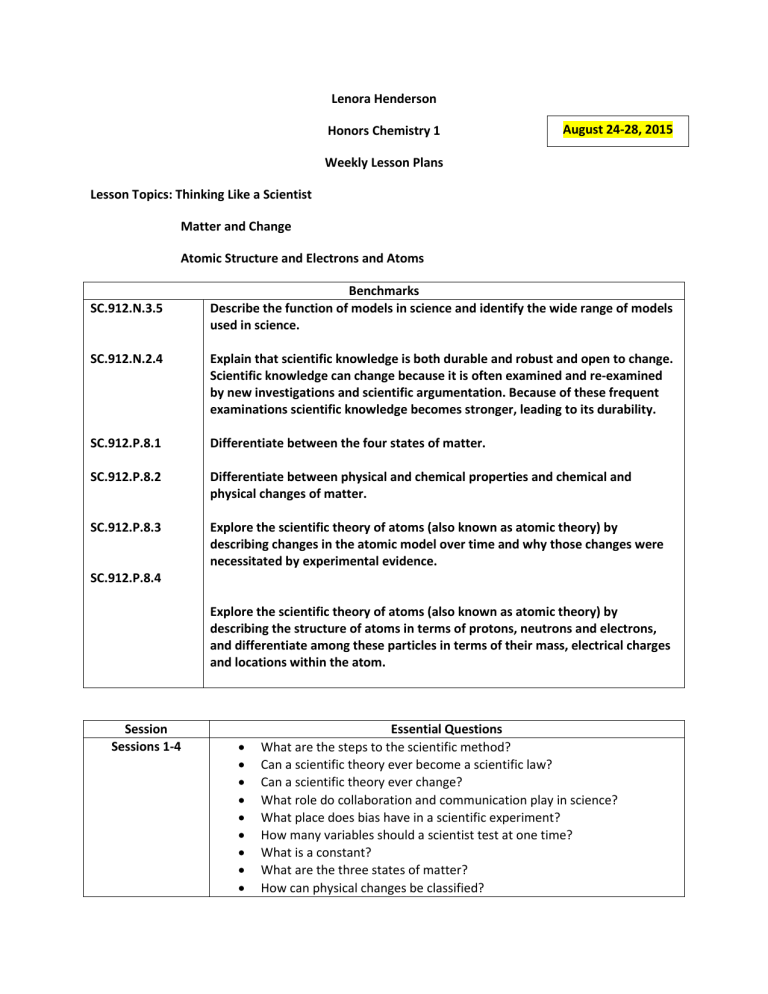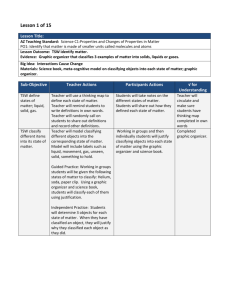August 24-28, 2015 Lenora Henderson Honors Chemistry 1 Weekly

SC.912.N.3.5
SC.912.N.2.4
SC.912.P.8.1
SC.912.P.8.2
SC.912.P.8.3
SC.912.P.8.4
Lenora Henderson
Honors Chemistry 1
Weekly Lesson Plans
Lesson Topics: Thinking Like a Scientist
Matter and Change
Atomic Structure and Electrons and Atoms
August 24-28, 2015
Benchmarks
Describe the function of models in science and identify the wide range of models used in science.
Explain that scientific knowledge is both durable and robust and open to change.
Scientific knowledge can change because it is often examined and re-examined by new investigations and scientific argumentation. Because of these frequent examinations scientific knowledge becomes stronger, leading to its durability.
Differentiate between the four states of matter.
Differentiate between physical and chemical properties and chemical and physical changes of matter.
Explore the scientific theory of atoms (also known as atomic theory) by describing changes in the atomic model over time and why those changes were necessitated by experimental evidence.
Explore the scientific theory of atoms (also known as atomic theory) by describing the structure of atoms in terms of protons, neutrons and electrons, and differentiate among these particles in terms of their mass, electrical charges and locations within the atom.
Session
Sessions 1-4
Essential Questions
What are the steps to the scientific method?
Can a scientific theory ever become a scientific law?
Can a scientific theory ever change?
What role do collaboration and communication play in science?
What place does bias have in a scientific experiment?
How many variables should a scientist test at one time?
What is a constant?
What are the three states of matter?
How can physical changes be classified?
Session 5
How can mixtures be classified?
What is another name for a homogeneous mixture?
What is a phase?
Can you classify mixtures as heterogeneous or homogeneous?
How are elements and compounds different?
What always happen during a chemical change?
What are the four possible clues that a chemical change has taken place?
How are the mass of the reactants and the mass of the products related in a chemical reaction?
How has the atomic model changed over time?
Session
Sessions 1-4
Session 5
Session
Sessions
1 and 2
Resources
Pearson-Laboratory
(Higher-Ordered
Henderson)
Session
3
Session
Henderson-Flashcards
Kagan
Learning Goals
The student should be able to:
Identify the independent and dependent variables in a scientific experiment.
Write an interpret hypotheses.
Distinguish between a scientific theory and a scientific law.
Identify bias data, and explain why it is so.
Apply and interpret the scientific method.
Distinguish between chemical and physical properties, and chemical and physical properties.
Classify physical and chemical properties, and physical and chemical changes.
Use particulate illustrations to identify the 3 major states of matter.
Use particulate illustrations to classify mixtures as heterogeneous or homogeneous.
Know the composition of a substance changes when it undergoes a chemical change.
Identify the reactant and the product in a chemical reaction.
Identify the four clues that indicate a chemical reaction.
Know that mass is conserved in all chemical and physical changes.
The student should be able to:
Explain how the atomic model has changed over time.
Pearson Testbank
Activities
X
Activity 1: Flashcards 1.3-2.4
Activity 2: Carousel Feedback
(Summarizes Chapters 1 and 2)
Assessments
Formative Assessment
Laboratory: Physical and
Chemical Changes
X
Summative Assessment:
4
Session
5
(Higher-Ordered
Henderson)
Henderson-Scientists
Data Table Graphic
Organizer
Henderson-Scientists
Data Table Graphic
Organizer
X
Homework: Jigsaw Graphic
Organizer Data Table
Jigsaw Scientists Graphic Organizer
Data Table
Students read and record hypothesis, experimental designs, observations, conclusions/discoveries
(Previously Assigned for homework)
Activity: Jigsaw, Expert Groups
Jigsaw, Teach each other
Test Chapter 1.3 and
Chapter 2
X







